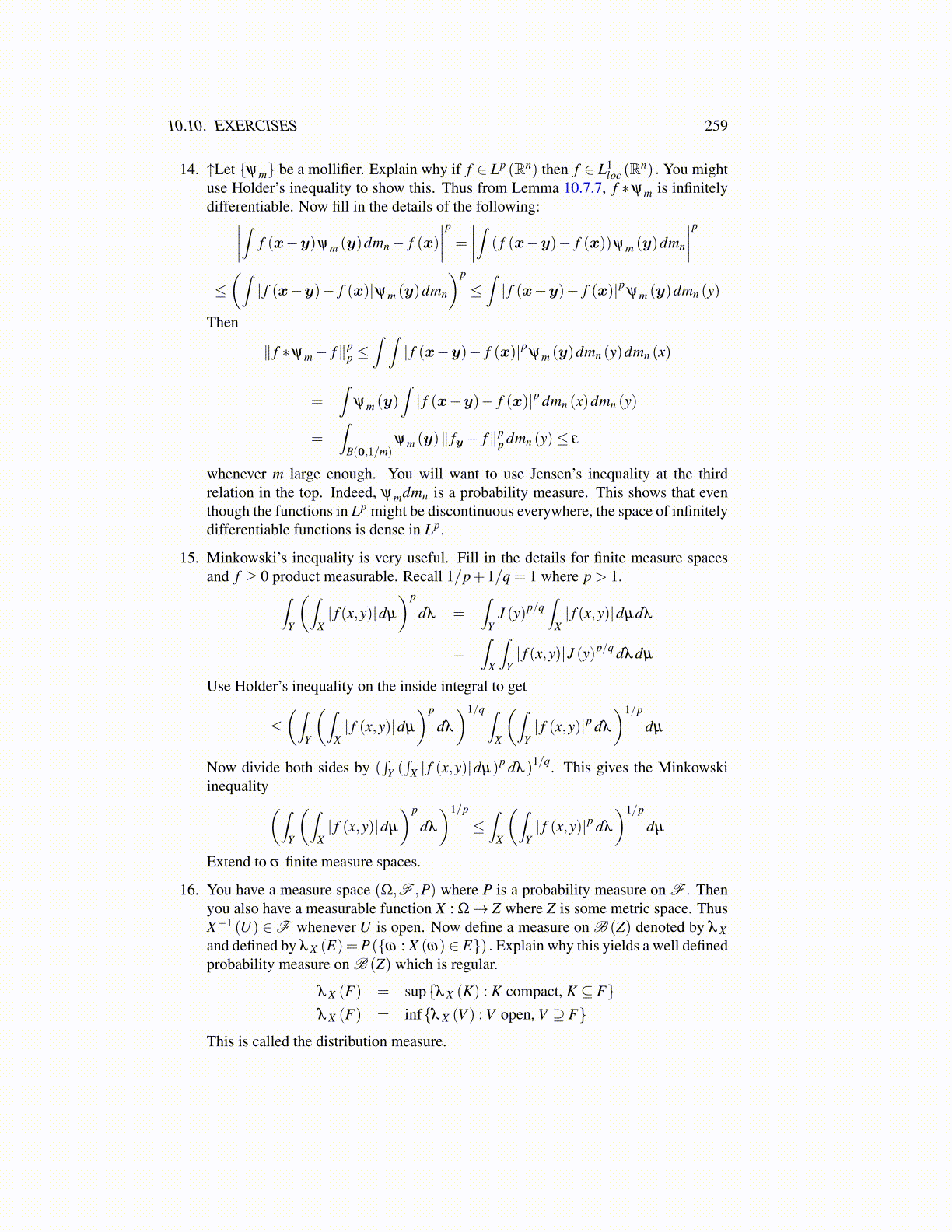
10.10. EXERCISES 259
14. ↑Let {ψm} be a mollifier. Explain why if f ∈ Lp (Rn) then f ∈ L1loc (Rn) . You might
use Holder’s inequality to show this. Thus from Lemma 10.7.7, f ∗ψm is infinitelydifferentiable. Now fill in the details of the following:∣∣∣∣∫ f (x−y)ψm (y)dmn− f (x)
∣∣∣∣p = ∣∣∣∣∫ ( f (x−y)− f (x))ψm (y)dmn
∣∣∣∣p≤(∫| f (x−y)− f (x)|ψm (y)dmn
)p
≤∫| f (x−y)− f (x)|p ψm (y)dmn (y)
Then
∥ f ∗ψm− f∥pp ≤
∫ ∫| f (x−y)− f (x)|p ψm (y)dmn (y)dmn (x)
=∫
ψm (y)∫| f (x−y)− f (x)|p dmn (x)dmn (y)
=∫
B(0,1/m)ψm (y)∥ fy− f∥p
p dmn (y)≤ ε
whenever m large enough. You will want to use Jensen’s inequality at the thirdrelation in the top. Indeed, ψmdmn is a probability measure. This shows that eventhough the functions in Lp might be discontinuous everywhere, the space of infinitelydifferentiable functions is dense in Lp.
15. Minkowski’s inequality is very useful. Fill in the details for finite measure spacesand f ≥ 0 product measurable. Recall 1/p+1/q = 1 where p > 1.∫
Y
(∫X| f (x,y)|dµ
)p
dλ =∫
YJ (y)p/q
∫X| f (x,y)|dµdλ
=∫
X
∫Y| f (x,y)|J (y)p/q dλdµ
Use Holder’s inequality on the inside integral to get
≤(∫
Y
(∫X| f (x,y)|dµ
)p
dλ
)1/q ∫X
(∫Y| f (x,y)|p dλ
)1/p
dµ
Now divide both sides by (∫
Y (∫
X | f (x,y)|dµ)p dλ )1/q. This gives the Minkowski
inequality(∫Y
(∫X| f (x,y)|dµ
)p
dλ
)1/p
≤∫
X
(∫Y| f (x,y)|p dλ
)1/p
dµ
Extend to σ finite measure spaces.
16. You have a measure space (Ω,F ,P) where P is a probability measure on F . Thenyou also have a measurable function X : Ω→ Z where Z is some metric space. ThusX−1 (U) ∈F whenever U is open. Now define a measure on B (Z) denoted by λ Xand defined by λ X (E)=P({ω : X (ω) ∈ E}) . Explain why this yields a well definedprobability measure on B (Z) which is regular.
λ X (F) = sup{λ X (K) : K compact, K ⊆ F}λ X (F) = inf{λ X (V ) : V open, V ⊇ F}
This is called the distribution measure.